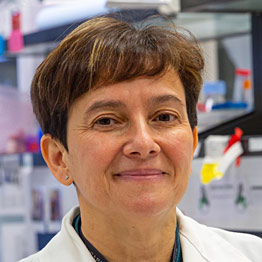27/02/2023
Published in
Dr. Gloria Gonzalez Aseguinolaza | Dr. Gloria Gonzalez Aseguinolaza
Director of Innovation and Transfer. Cima University of Navarra
 February 28 is the World Rare Disease Day. Although they are so called because they are rare (each of them affects less than 5 out of every 10,000 inhabitants), as a whole they are suffered by thousands of people, since it is estimated that there are more than 7,000 rare diseases in the world. It is estimated that 300 million people suffer from a rare disease; 3 of them in Spain. Most of these diseases manifest themselves in childhood due to their genetic origin. For this reason, gene therapy has revolutionized the treatment of these patients. This technique seeks to cure a disease caused by the lack or dysfunction of a gene by replacing it with its correct version. To achieve this "restitution Genetics" it is necessary to deliver the correct information Genetics to the patient's cells. To do this, vehicles or vectors are used, generally viruses modified in the laboratory that lose their capacity to cause disease, but maintain their skill to penetrate the cells, introducing the correct information Genetics .
February 28 is the World Rare Disease Day. Although they are so called because they are rare (each of them affects less than 5 out of every 10,000 inhabitants), as a whole they are suffered by thousands of people, since it is estimated that there are more than 7,000 rare diseases in the world. It is estimated that 300 million people suffer from a rare disease; 3 of them in Spain. Most of these diseases manifest themselves in childhood due to their genetic origin. For this reason, gene therapy has revolutionized the treatment of these patients. This technique seeks to cure a disease caused by the lack or dysfunction of a gene by replacing it with its correct version. To achieve this "restitution Genetics" it is necessary to deliver the correct information Genetics to the patient's cells. To do this, vehicles or vectors are used, generally viruses modified in the laboratory that lose their capacity to cause disease, but maintain their skill to penetrate the cells, introducing the correct information Genetics .
More than 50 years ago, in 1972, the American researchers Theodore Friedmann and Richard Roblin first proposed the use of these genetically modified viruses to treat genetic disorders. However, the concept of gene therapy became known at the end of the 1970s following the development of recombinant DNA technology development , which made it possible to cut and join DNA sequences of interest. It was not until 1990 that the first essay gene therapy was performed in humans: a 4-year-old girl with a severe immunodeficiency subject . Since then, gene therapy has been tested in clinical trials for a multitude of hereditary diseases, cancers and infectious diseases and is progressively changing the landscape of modern medicine. Thus, the FDA and EMA (the drug regulatory agencies in the United States and Europe, respectively) have C six gene therapy drugs and more than 3,000 clinical trials using these therapies have been registered.
Gene therapy with adeno-associated virus (AAV)-based vectors now offers a realistic therapeutic option for otherwise incurable diseases, such as most hepatic metabolic disorders of genetic origin. These diseases may benefit from gene transfer to the liver using AAVs. Genetic diseases associated with deficiencies of proteins secreted into the bloodstream, such as hemophilia, which is caused by the liver's inability to produce blood clotting factors, also benefit from this strategy. C In this regard, the FDA recently approved the first gene therapy for hemophilia B, and another for hemophilia A is about to be approved.
In addition to hemophilia, gene therapy has demonstrated therapeutic efficacy in preclinical programs of study of several genetic hepatic metabolic indications, such as familial hypercholesterolemia, Crigler-Najjar syndrome, Wilson's disease, acute intermittent porphyria, tyrosinemia, phenylketonuria, urea cycle diseases, or progressive familial intrahepatic cholestasis, among others. Consequently, the issue of clinical trials for genetic liver disorders is steadily increasing, and many of them have yielded promising patient outcomes.
Fundamental to the development of gene therapy has been the advance in the knowledge of the genetic causes of diseases, the improvement of gene delivery systems and the development of new therapies based on nucleic acids and genomic engineering technologies. In addition, the biomedical and technological research developed in recent years has opened the door to new gene therapy strategies. Initially, it consisted solely of correcting defective genes to treat diseases. However, it has gradually evolved into other approaches, such as gene silencing and precise modification of the cell genome. The development of CRISPR-Cas9 technology - the Swiss Army Knife of gene editing - is one of the most exciting and promising scientific advances of the last decade.
Despite the results obtained to date with gene therapy, there remain innumerable difficulties in translating research into the clinic in this field. Novel approaches involving delivery of genetic material to cells or manipulation of genomic DNA require great caution and careful assessment of all possible effects before approval.
The treatment of rare diseases by gene therapy is already a reality, but some safety and toxicity problems need to be solved to achieve standardized administration. Today is a day to raise awareness of rare diseases, but also to demand more investment in research and to ensure that scientific advances are translated into new treatments that improve the quality of life of patients with a rare disease.
